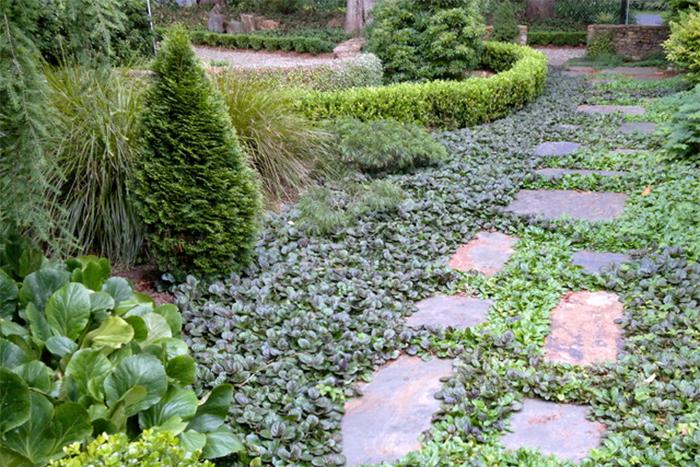Menu
Ground cover plants are naturally low growing, spreading specimens which are great for covering bare areas. Most are fairly low maintenance and many are also evergreen, providing a year-round backdrop of colour in your garden.
They are surprisingly versatile, hardy plants but are often under-rated in the garden. We have identified the key reasons why we think you’ll want to consider ground cover planting, as well as looking at some of the popular plants to choose.
Ground cover plants don’t just fill large expanses of bare soil, they are great for filling smaller gaps in your borders too. If you have bare spots around the base of roses or shrubs, the right plant will soon grow into it. If you have a slope or other tricky patches, which are perhaps difficult to reach, a ground cover plant will quickly fit in and be low maintenance. Some ground cover plants are even suitable for growing as an alternative to the traditional grass lawn.
Planting the same variety of ground cover plant in different spots around your garden will help to tie the garden together, making it feel like a unified design.

Ground cover plants can act like a ‘living mulch’ to prevent weeds or other self-sown seeds taking root. It’s important to weed your soil thoroughly before planting them but, once established and spreading, they can block light from anything trying to grow beneath them.
The mulch-like properties of ground cover planting extend to more than just weed reduction; they can help lock moisture and nutrients into your soil under the cover of their leaves, alleviating the drying effects of scorching sunlight or harsh winds.
If you have sloping areas or poor, thin soil that is prone to eroding, picking a variety that will grow an expansive root network will help to stabilise the soil, helping to prevent it being washed away. Many ground cover plants tolerate poor soils so can grow where other plants won’t do so well.

Most of us have paths, patios, walls or driveways in our gardens, made of brick, stone or wood. Against our planting, these can sometimes look too harsh. The answer is to soften those edges with some low-growing or trailing planting.
We’ve already shown how the right ground cover plants can provide a ‘barrier’ from extremes of weather, thus helping to protect other plants in your garden. They can help prevent soil erosion, particularly useful as flooding seems to be becoming more common.
Replacing your lawn with a single variety, or even a tapestry, of ground cover plants could make it both lower maintenance and more tolerant of the extremes of weather. Many ground cover plants have flowers or berries that are attractive to wildlife, offering a useful lifeline to nature’s visitors to our gardens as well.

Most gardens are designed around a few focal points, be that specimen plants or garden features like buildings or seating areas. Clever use of the right ground cover planting will act as a foil for these, helping to show them off even more.
Imagine a specimen tree, sitting in its own round bed, strategically placed to draw your eye into your garden. Now think how much more pleasing that tree would look if it was under-planted with a blanket of green, echoing or contrasting with its own foliage. Ground cover can help you make your garden even more spectacular.
There are so many great ground cover plants to choose from, narrowing it down to only five is a really tough ask! We have tried to pick five plants that have different qualities to help show the potential of what ground cover planting could do in your garden. Have a chat with our plant experts in Centre if you’d like some specific advice for your particular spot. (And, if just five isn’t enough for you, we’d recommend this article from Gardeners World, who have picked their top twenty!)

Great for covering a tricky area, like a slope or dry shade. It’s evergreen and grows fast, with pretty blue, white or purple flowers in spring and summer. It can be a bit of a thug planted in a bed or border but, to tackle a tricky spot, it can be your best friend!

Great for sunny spots and wildlife, particularly in more acidic soil. Evergreen and with flowers that bees love, there are a wide variety of heathers to choose from, which often provide food for wildlife when not much else is flowering in the garden.

Great for blocking weed growth. Alchemilla mollis has broad leaves which grow anew each spring, making them great for preventing weeds growing around them. Although not evergreen, their growing season does coincide with the growing season of most weeds!

Great for year-round interest and culinary use. This low growing evergreen has minty leaves which can be dried and made into tea. It has attractive red berries in winter and is happy in acidic soil. (There are lots of other low-growing herbs with herbal properties which also make great ground cover plants too!)

Great for autumn colour and under-planting. A relative of the grape hyacinth, this is an evergreen perennial which will reward you with delicate spikes of purple-blue flowers in the autumn. Being pretty drought-tolerant also makes it great for planting under hedges, trees or shrubs.
Hambrooks garden design, landscaping & garden maintenance throughout Hampshire for over 50 years.

